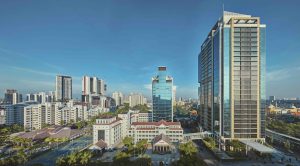Philippines – Asia’s Fastest Growing Economy
Share story

At seven per cent, Philippines’ economy has steadily been expanding at Asia’s highest rate within the second quarter of this year. The inflation rate, however, is just 1.8 per cent despite the rapid rise of domestic spending and a growth in wages that remains flat, reflecting the growing disparity between the wealthy, and the man on the street.
The Philippines is also the third largest recipient of inward remittances from their overseas foreign workers (OFWs). Every year, about US$30 billion (RM125 billion) flows in from its 10 million OFWs, a number only surpassed by China and India. This inflow provides a consistent source of income and supports a major portion of the country’s domestic spending.
The economy is made up of three main sectors – 60 per cent services, 30 per cent manufacturing and 10 per cent agriculture. The highest growth is seen in the service sector, particularly in the provision of business process outsourcing (BPO). This once underrated but well-educated, English-speaking nation has recently overtaken India as the most favorable location for BPO, with demands from major trading partners such as the United States, China, Japan, Singapore and South Korea. According to studies by Deloitte, BPO in the Philippines is growing at 15 per cent a year and is expected to contribute US$25.5 billion (RM106 billion) to the economy in 2016, while providing 1.4 million jobs. In fact, in its 2015 report, the OECD expects Indonesia and the Philippines to lead ASEAN growth through 2019.
However, taking the Philippines’ economy beyond its current state will require greater ambition than is currently evident. It is critical that Philippines takes advantage of its current growth to strengthen its economy, infrastructure, domestic consumption and create an environment friendly to foreign capital. A rise in the housing market would necessarily follow, with growth not constrained to high-end or foreign-owned assets.
We believe Philippines market is well established for a long period of prosperity, given its GDP distribution and the growing BPO trend. However, overseas remittance, being the strongest contributor to domestic consumption, does indeed pose a risk as it looks to slow down among global economic headwinds and the strengthening of the domestic economy.
Economy aside, the housing market has seen significant growth over the last decade with increasing foreign participation. Investors across Singapore and Malaysia have purchased properties in view of the relatively lower prices. In this article, we will attempt to provide several key points which are critical for investors to consider as they venture into this seemingly rising market.
Ownership of Properties
by Foreigners
In the Philippines, foreigners can only own 40 per cent of any condominium. Land can only be acquired on a 60 per cent- 40 per cent basis, where such properties must be 60 per cent owned by a Filipino. The same rules apply to the acquisition of assets using corporate structures.
Taxes & Duties
Taxes and duties in the Philippines are relatively benign. Here are some of the more common taxes and duties that one should take note when investing in the Philippines.
Do note that tax can be a complicated topic and investors are well advised to speak to their tax consultants for assistance on their specific class of assets.
Mortgage/Loans
Mortgage for properties in the Philippines used to come with exorbitant interest rates. Today, the options have expanded with not only the local banks but also with international banks including HSBC. Interest rates can now range from 4.5 per cent to as high as 11.5 per cent depending on the term of the loan. Banks typically would like to see commitment to the market or higher deposit to mitigate against risks of you walking away from the asset.
Recent changes in lending rules as part of an effort to rein in prices have seen some banks adjusting their borrower requirements. Philippines National Bank (PNB) in Singapore, for example, now requires majority ownership of the property to be a Filipino earning more than S$48,000 (RM144,000) per annum. If that requirement is not fulfilled, buyers will have to seek alternatives with developers.
Supply & Demand & Property Bubble?
To skirt around a lack of lending options and price point tolerance of foreign investors, developers have in the last few years came up with micro studios (with buildup of below 25sq m), costing between S$50,000 (RM150,000) and S$80,000 (RM240,000). Some developers take it to the extreme, building over 1,000 units of micro studios in a single project. This has added significant stock to the central Manila market.
A few words about these apartments: We are of the opinion that these units are built to sell, and are not built for the local market. Capital growth will be extremely limited and rental, given the excessive supply, will be challenging. We advocate strongly against these properties.
With growing affluence and the rise of the middle class, our preference for our clients would be towards good sized homes, catering to families, mid-level executives and above. Vacancy rates of these prime properties is at a healthy 6+ per cent, while the overall Makati CBD is experiencing the highest level of vacancy (nine per cent), and a trend that is expected to continue to rise. Rental growth has stalled and might fall as additional supply hits the market. It is no surprise the government is now holding back development permits and developers are delaying new launches.
While house prices might not be falling anytime soon, do expect a slight slowdown due to the glut of supply coming online. We would not call it a severe bubble, and in fact the present slowdown might present buying opportunities. Of course, only the right products will work.




